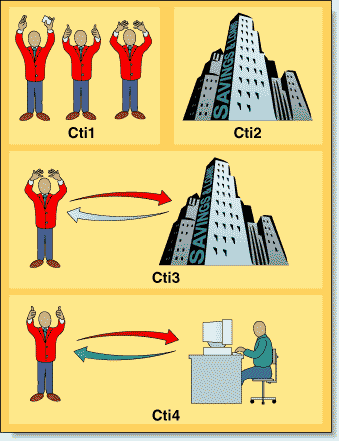Market Profile Exotics
The Liquidity Data Bank
by Jayanthi Gopalakrishnan
In this followup to last month's article on Market Profile, we go beyond Market Profile to determine price movements. Here's a look at the Liquidity Data Bank, which helps traders detect price movements early.

FIGURE 1: DIFFERENT TYPES OF TRADERS. The four different types of traders are the floor trader (Cti1); the commercials (Cti2); members filling orders for other members and nonclearing commercial traders (Cti3); and members filling orders for the public or for other types of customers (Cti4).
The key to detecting the reversal points is through analyzing the volume traded. Apart from providing the Market Profile, the Chicago Board of Trade (CBOT) also provides the Liquidity Data Bank (LDB), which indicates the volume traded at each price level. Not only does it provide the total volume traded at each level, but also divides up the volume by types of traders.
TRADER TYPES
There are four different types of traders. They are indicated by the letters Cti, which stand for "Customer trade indicator." The types (Figure 1) are:
Cti1 Floor traders
Cti2 Commercial clearing members
Cti3 Members filling orders for other members and nonclearing commercial traders
Cti4 Members filling orders for the public or any other type of customer.
These four types of traders have different objectives and different trading styles. Floor traders, Cti1, make up the largest percentage of volume traded. Their interest is to trade a few ticks on large volume, and they are the ones who provide liquidity to the markets and form the essence of the futures market.
The commercial traders, Cti2, represent firms such as grain merchants, livestock producers, and savings and loan institutions. These traders buy and sell contracts for their inventory. Further, they receive market-related information prior to any other type of trader, and monitoring their activity can provide clues for your own trading. Later, I will discuss the trading style of the commercial trader and how it can help you observe certain factors in market activity.
The traders represented by Cti3 and Cti4 are known as residual traders and represent about 25% to 35% of the day's volume. They tend to react to trades in a similar manner and usually in a wider range than do floor traders and commercials. In Figure 2, you can see the breakdown of the volume among these four types of traders.
Jayanthi Gopalakrishnan is a Staff Writer for STOCKS & COMMODITIES.
Excerpted from an article originally published in the January 2000 issue of Technical Analysis of STOCKS & COMMODITIES magazine. All rights reserved. © Copyright 1999, Technical Analysis, Inc.
Return to January 2000 Contents